Sword Cleaning
You've stepped up and gotten a real sword but don't have a clue on how to
maintain it. We'll let you know what you supplies you need and how to use
them. Katana must be cleaned immediately after tameshigiri and at the end
of class. Unlike most decorative wall hangers - real katana rust! If
the blade is touched - it needs to be immediately cleaned unless you want to
personalize your blade with rust fingerprints.
Nihonzashi LLC, its employees, and associated
companies are not responsible for any injury, damage or loss incurred by
following any advice given on this site. Katana are dangerous objects and
the utmost care should be given when working with them.
You can find all these on the
Maintenance page in our equipment section. These should also be
available from most quality stores carrying swords. We recommend using the
proper supplies to minimize risk to your investment, but we also let you know
alternatives that can be used.
Nuguigami: Wiping Paper for Sword Made of a soft, sensitive pulp tissue Made
exclusively for wiping your sword. Wipes off the excessive oil and unnecessary
dust. Common substitutes are soft paper towels or tissue paper (don't use
those with scents or lotion).
Wiping cloth: A flannel cloth, old towel, or hand-cloth can be used for quick
cleaning to wipe debris and residue from the blade after tameshigiri or
handling. This cloth can be reused multiple times. Nuguigami, paper
towels, or tissue paper (don't use those with scents or lotion) can also be
used, but should not be reused.
Choji Oil: A superb rust preventive oil. This is not clove oil which will
cause your blade to rust. Common substitute is camelia or mineral oil.
Oiling Cloth: Flanel cloth in a storage case used to apply a coating of choji
oil to the blade. This cloth can be reused multiple times. Nuguigami,
paper towels, or tissue paper (don't use those with scents or lotion) can also
be used, but should not be reused.
Uchiko Ball: Finely ground stone powder (hazuya and jizuya) in a silk ball.
Your should do a quick cleaning immediately after handled your sword or after
performing tameshigiri (test cutting). This cleans off any corrosive
residue off the blade.
- Prepare all the materials you need before removing the katana from the
saya (scabbard). You will not be setting the katana down and everything you
don't do here will need to be done with one hand. You will need a wiping
cloth, oiling cloth, and choji oil (sword oil). Make sure the oiling cloth
is saturated with choji oil.
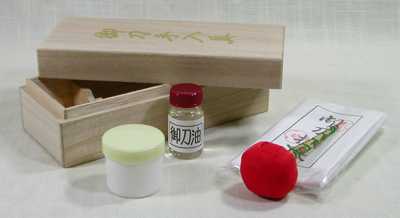
- Carefully remove the blade from the saya. The saya should be held in
the left hand and the sword should be drawn out with the right hand. The
left hand should remain motionless with the right hand doing the effort.
The sword is held edge up and the blade should slide on the mune (back
surface away from edge). The kissaki (tip) of the katana should be always be
kept pointing slightly upwards. This is a good habit since a katana may not
always have a mekugi (bamboo pin in handle) to keep the tsuka (handle) on.
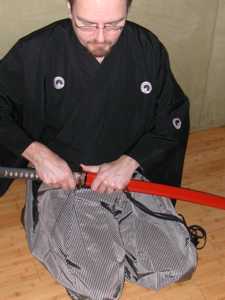
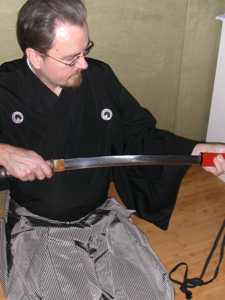
- Gently tap any debris from the saya (scabbard). Tameshigiri (test
cutting) often leaves pieces of the target on the blade and these can build
up in the saya. These can cause the blade to become corroded and eventually
cause the katana to not seat properly. The koiguchi (mouth) of the saya can
be tapped on a semi-hard surface, but care should be taken since the water
buffalo horn ring on some saya tend to fracture. The saya can then be laid
down on your left side.
- Wipe any debris and residue from the blade with the wiping cloth. Hold
the tsuka (handle) in your left hand with the ha (edge) pointed away from
yourself. Lay the wiping cloth on the top of the blade at the habaki (blade
collar). Wipe only in one direction from the tsuba (guard) to the kissaki
(tip). Use your thumb running along the mune (back of the katana) to keep
you fingers away from the ha (edge). You should only need to wipe the blade
once or twice, but make sure all residue has been removed. Lay the wiping
cloth on your hand and repeat the process on the bottom of the blade. If
your katana has bo-hi (grooves) make sure you wipe them by pinching the
wiping cloth between your fingers.
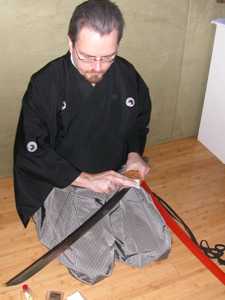
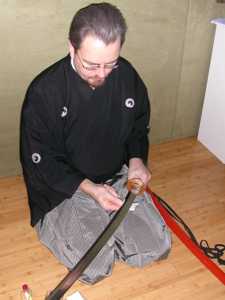
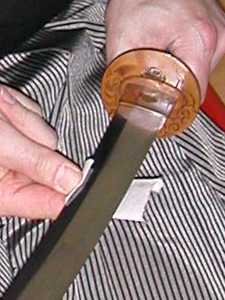
- Oil the blade using the oiling cloth. This is the same process as the
previous step. The blade only needs to be wiped once. The entire surface
of the blade needs to be covered. Try not to get too much oil on or under
the habaki (blade collar).

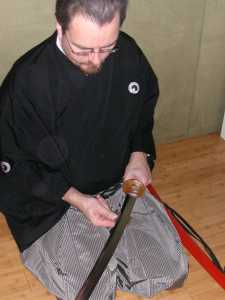
- Put the katana back in the saya reversing the process used to remove
it. The katana should not be slammed back into the saya since this can
damage the koiguchi (mouth) of the saya.
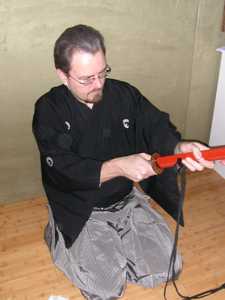 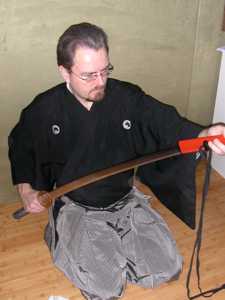
You should do a normal cleaning before putting the sword away. This
should be done at home after training.
- Prepare all the materials you need before removing the katana from the
saya (scabbard). You will not be setting the katana down and everything you
don't do here will need to be done with one hand. You will need two pieces
of nuguigami (wiping paper), oiling cloth, choji oil (sword oil), and an
uchiko ball (cleaning powder). Make sure the oiling cloth is saturated with
choji oil.

- Carefully remove the blade from the saya. The saya should be held in
the left hand and the sword should be drawn out with the right hand. The
left hand should remain motionless with the right hand doing the effort.
The sword is held edge up and the blade should slide on the mune (back
surface away from edge). The kissaki (tip) of the katana should be always be
kept pointing slightly upwards. This is a good habit since a katana may not
always have a mekugi (bamboo pin in handle) to keep the tsuka (handle) on.


- Gently tap any debris from the saya (scabbard). Tameshigiri (test
cutting) often leaves pieces of the target on the blade and these can build
up in the saya. These can cause the blade to become corroded and eventually
cause the katana to not seat properly. The koiguchi (mouth) of the saya can
be tapped on a semi-hard surface, but care should be taken since the water
buffalo horn ring on some saya tend to fracture. The saya can then be laid
down on your left side.
- Wipe any choji oil from the blade with a clean piece of nuguigami
(wiping paper). Hold the tsuka (handle) in your left hand with the ha
(edge) pointed away from yourself. Lay the nuguigami on the top of the
blade at the habaki (blade collar). Wipe only in one direction from the
tsuba (guard) to the kissaki (tip). Use your thumb running along the mune
(back of the katana) to keep you fingers away from the ha (edge). You
should only need to wipe the blade once or twice, but make sure all oil has
been removed. Lay the wiping cloth on your hand and repeat the process on
the bottom of the blade. If your katana has bo-hi (grooves) make sure you
wipe them by pinching the nuguigami between your fingers.



- Use the uchiko ball (cleaning powder) on the blade once the choji oil
has been removed. Choji oil will clog the surface of the uchiko ball if it
has not been removed. The uchiko ball is tapped every few inches along the
shinogi (flat surface on the top side of the blade). Uchiko is a very mild
abrasive and should not be used on aluminum iaito blades. Wipe the uchico
off the blade with a fresh piece of nuguigami using the same process as the
previous step. Note that this is the best time to view a katana. You will
need to repeat this step if you use this opportunity to view or show your
katana.
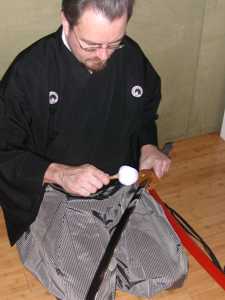

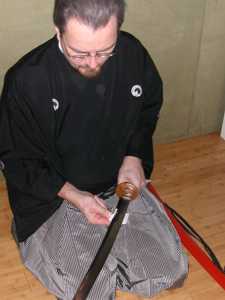
- Oil the blade using the oiling cloth. This is the same process as the
previous steps. The blade only needs to be wiped once. The entire surface
of the blade needs to be covered. Try not to get too much oil on or under
the habaki (blade collar).


- Put the katana back in the saya reversing the process used to remove
it. The katana should not be slammed back into the saya since this can
damage the koiguchi (mouth) of the saya.
 
|